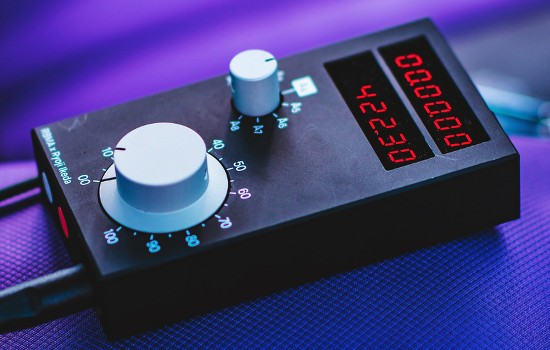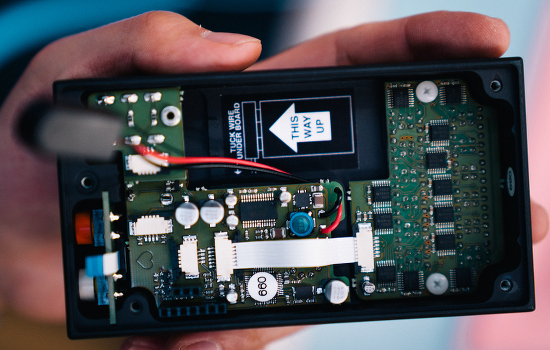09 Nov We made 100 unique Synths for Ryoji Ikeda
In early summer, synth-designer Tatsuya Takahashi brought us in the loop about a project he had lined up with composer and sound artist Ryoji Ikeda: A 100 Car Symphony in Los Angeles, an immersive open-air sound installation in the middle of the city. We teamed up to engineer an amazing device for the show!

Handheld Synthesizer for A [for 100 cars]. 📷 Drew Gurian
The Composition
The composition was based on the note A4 and it’s historic frequency variations of the last couple of centuries and would be played from the sound systems of 100 cars from different LA car cultures and their drivers. A rugged and precise instrument was required to play the piece, which was handed out as a musical score for each driver.
Inside the Synth
Although the synth only had to generate sine waves, it required a very high frequency precision in the milli-Herz range and low distortion. A microcontroller generates all sounds digitally, based on an algorithm called “the Magic Circle”, which spits out pure sine/cosine waveforms. No tables or interpolations were used, purely generative synthesis.
As the piece was played simultaneously by 100 people, they had to be syncronized by a timer on each device. One dozen low current LED displays show the current time during the performance as well as the individual frequency. The rest of the user interface consists of a rotary octave switch and a big, high torque volume knob. The handheld device was powered by a 9V lithium block and energy had to last for rehearsals and performance. Proper power management was implemented to make the devices safe and indicate battery status before the final show.

Inside the device. 📷 Carys Huws
We designed a case around the idea of a monolithic aluminium block, sand blasted and anodized, with heavy knobs, a high contrast display and stuffed it with electronics. To be able to maintain the design of the user interface and to deal with the high density of components and battery, everything was spread across four different printed circuit boards, each mounted in a different plane. Each case was custom milled from a solid piece of aluminium to give the synth it’s rugged, clean and heavy appearance.
Read More
Being part of an art project again was great fun, a chance to gather experience in new manufacturing techniques and amazing to work with Tatsuya and Ryoji.
Read more about Tatsuyas point of view here, check Peter Kirn’s coverage on CDM, a writeup of the show in the New York Times or watch a video from RBMA.
